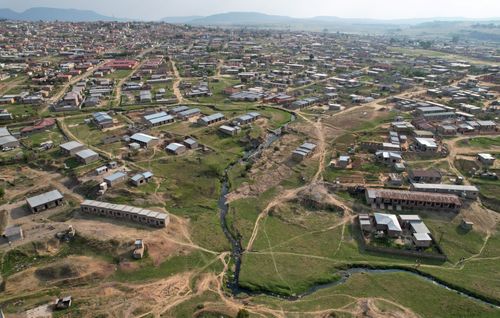Lesotho’s water-quality authorities have rejected independent, scientific tests that conclusively prove how chemicals from textile factories in two of the country’s industrial areas are being released into rivers. While water authorities blame communities living close to the rivers for river pollution, they promise to do their own tests when funds are available. Meanwhile, a parastatal responsible for attracting investors to Lesotho tried to stop the publication of MNN’s investigations saying that this would tarnish Lesotho’s name and destroy its textile industry.
MNN took water samples from rivers and streams that flow from the Thetsane and Maputsoe industrial areas. These water courses end up in the Mohokare River that separates South Africa (where it is called the Caledon River) and Lesotho. This water flows into the Orange-Senqu basin which extends across Lesotho, South Africa, Namibia and Botswana.
MNN sent the samples for testing to a South African National Standards-accredited lab in October 2022. The results confirmed high levels of chemical pollution along this water course.
MNN presented the findings to Lesotho’s department of water affairs. The department insisted that the pollution has nothing to do with the clothing and textile factories which create critical employment.
The department’s viewpoint was that pollution in Maputsoe was an issue that has been resolved. It also told MNN that a “spot check” was done in Thetsane area in 2021. Although this “spot check” did not involve chemical tests of water samples, officials concluded that the pollution was not from the factories. Nthati Toae, a hydrobiologist at the department of water affairs, explained that the department visited the Thetsane industrial area in2021 at the height of “allegations that the factories were polluting” and did a spot check. She confirmed that they found “nothing wrong with the industries” in that they were not the source of pollution.
However, Toae told the MNN Centre for Investigative Journalism that they found the “Mabolou stream very polluted”. But this pollution, said Toae, was not chemical, even though no water samples have been tested.
“Even with the smell, one could tell that it was human faeces, not industrial effluent,” she said, and explained that her department does its investigations by observation and taking water samples. However, regarding the 2021 visit, she said: “[We] didn’t take the samples for hygienic protection.” Instead, she said that they observed the stream and drew the conclusion that it was polluted by human waste, not industrial effluent.
In the case of Mabolou pollution, Toae said that the department had done a follow-up investigation through its Water Law Division, which confirmed that the foul-smelling water contained human faeces. The investigation concluded that it was coming from “a certain B&B” but Toae couldn’t remember the establishment’s name or when exactly the follow up investigation had been done.
Toae emphasised that the factories could not bypass the Water and Sewage Company’s waste drainage system because they are surrounded by large walls which prevented any possible release of wastewater into the stream.
She told MNN that the government would be conducting more comprehensive, scientific tests when funds were available.
Besides having a lack of resources, Independent Democratic Union of Lesotho Secretary General May Rathakane believes that regulators turn a blind eye to pollution, and questions why “on many occasions they [regulators] do not find the violations that we report”.
Lesotho’s Environment Act 2008, Section 19 (4) of Water Act, 2008, which clearly states that no persons shall damage, destroy or cause any harm to a natural spring. However, the authorities are not taking any enforcement measures.
The Department of Water took the photographs below to show that wastewater from the textile industries cannot be released into the stream.

On a sweltering day, 20 September 2022, Mabereng Phaloane seeks shelter from the blistering sun in her five-roomed brick house in Thetsane. Her house, along with the flats she rents out, are separated from a factory that manufactures jeans by a 2m-wide stream. Phaloane leads the MNN crew to circle-shaped holes in the walls of the NienHsing International Lesotho factory, through which she says wastewater regularly flows into the stream.
Phaloane told MNN that Nien Hsing International Lesotho releases the blue wastewater in high quantities from around5pm every day. Nien Hsing International is the biggest producer of jeans in Lesotho.
The MNN team visited the factories in the area several times in September and October, and in stark contrast to the pictures taken by the department, took the photographs below that show wastewater being released into the stream.


The MNN approached Nien HsingTextile of Taiwan and its Lesotho-based subsidiary, Nien Hsing InternationalLesotho, to comment on water pollution linked to their factories at HaThetsane. On 5 January, the Lesotho National Development Corporation (LNDC),which is a parastatal responsible for attracting investors, invited the MNN fora meeting with the Lesotho subsidiary, saying Nien Hsing had asked the corporationfor assistance in responding to our emailed questions.
Nien Hsing declined to have anyinterview recorded because it did not have permission from Taiwan and wentquiet until 17 January when MNN sent a follow-up email.
The following day, Nien Hsing requestedthe MNN to avail its scientific report to “enable the relevant authorities tolearn the report so that they provide proper guidance” which MNN did. Thefactory has to date given no interview or response to MNN’s questions.
On 18 January, LNDC interim chief executive officer Molise Ramaili, General Manager Investments Puseletso Makhakhe, Manager Investments Moeketsi Khoele and Industrial Officer Mamphaphathi Molapo called the MNN team for a meeting, that turned into an attempt to gag this five-part exposé.
The LNDC claimed that publishing this five-part investigation would destroy the textile industry and tarnish Lesotho’s name and that it needed until 23 January to liaise with the departments of water, environment, and health for verification of MNN’s findings. MNN had not received any answers or explanations by the time of publication. Lookout for Part 4 in the series. Shortly after MNN published this story on January 25 the LNDC contacted MNN asking for another meeting with a government technical committee that had been established to “urgently attend to this environmental issue”.
Meanwhile, Phaloane says villagers within sight of Nien Hsing continue to helplessly witness the water pollution by the firm as authorities ignore their pleas for help. “We have tried all the avenues we know of to stop this, but no help has come,” she said.
Phaloane said more polluted waterflows from the factory when it rains. She suspects this is done so that the blue water can be washed away quickly without being noticed. On a cloudy 21 October evening, the MNN team visited the confluence of the Mabolou River and Mohokare River to take water samples and found the former overflowing with blue water with a foul, chemical smell.

Watch the video below for more detail.
In an effort to determine where the traces of the blue substance on the streambanks came from, the MNN flew a drone camera over one of the factories. Footage over the Formosa factory, another subsidiary of Nien Hsing Textiles, shows trenches of a blue substance next to the company’s water-treatment plant.
The aerial view of the blue substance is shown in the picture below.

MNN’s investigations also included thepart of the Mohokare River that is downstream from the Maputsoe industrial area.Wastewater from a blocked and neglected manhole spills over and flows freelythrough the village, in between the homes of Ha Maputsoe’s residents and intothe Mohokare River, polluting the unprotected well that the villagers use fordrinking water and other purposes.


Another two samples were taken from the manmade wastewater stream flowing through Ha Maputsoe village and another from the unprotected well.
The samples were taken for testing at Aquatico Scientific (Pty) Ltd., a South African National Accreditation System-accredited water testing laboratory and environmental monitoring company based in Pretoria.
According to the Aquatico laboratory report, the upper stream of Mohokare River water had a very high level of suspended solids. However, when compared to the two points where industrial pollution was visibly present, the levels of ammonium, manganese and chemical oxygen demand (COD) exceeded the legally accepted limits.

Aquatico says that this water shouldn’t be released into aquatic ecosystems because it could destroy the environment and aquatic life of its high levels of suspended solids, ammonium and COD.
“Based on the analysed variables, none of the localities (Mohokare at Mabolou and at Ha Maputsoe confluences) has water that is suitable for human consumption. The manganese concentration at Mohokare in Maputsoe will also have a negative effect on crop yield. See full report here.
The lab tests showed that the concentrations of ammonium, manganese and turbidity in the water from the factories that flows through the village were higher than the limit allowed by SANS 241:2015. Aquatico advised against discharging water from this point into the environment due to its negative effects on aquatic ecosystems.
The water in the well was found to have an extremely high concentration of nitrates and was “not fit for human consumption or domestic use”. The same water that the villagers regularly drink is “not to be used as a water source for cattle as it was not fully compliant with the Livestock Watering Guidelines”. See full report here.


In both districts, factories operate next to the Mohokare river and their effluent, in all three cases, is discharged into the river, polluting the water sources poor communities depend on daily.
Communities bear brunt of branded fashion for First World
While communities bear the brunt of the pollution, the global fashion industry benefits from garments made in Lesotho. Buyers of these clothes include some of the world’s best known jean retailers.
According to the Nien Hsing Textile website, its Lesotho subsidiary has three garment plants and employees 3,264 people. These plants mainly produce jeans and have the capacity to produce 23,000 pieces per day. The website lists some of the world’s biggest brands and retailers as buyers of the company products.
Nien Hsing’s Formosa Textiles is one of the three plants in Lesotho and this plant produces denim fabric at a capacity of 35,000kg per day. Its operations include ring spinning, dying, weaving and finishing.

This story was produced by the MNN Centre for Investigative Journalism and syndicated by the IJ Hub on behalf of its member centre network in Southern Africa

Discover more from MAKANDAY
Subscribe to get the latest posts sent to your email.



